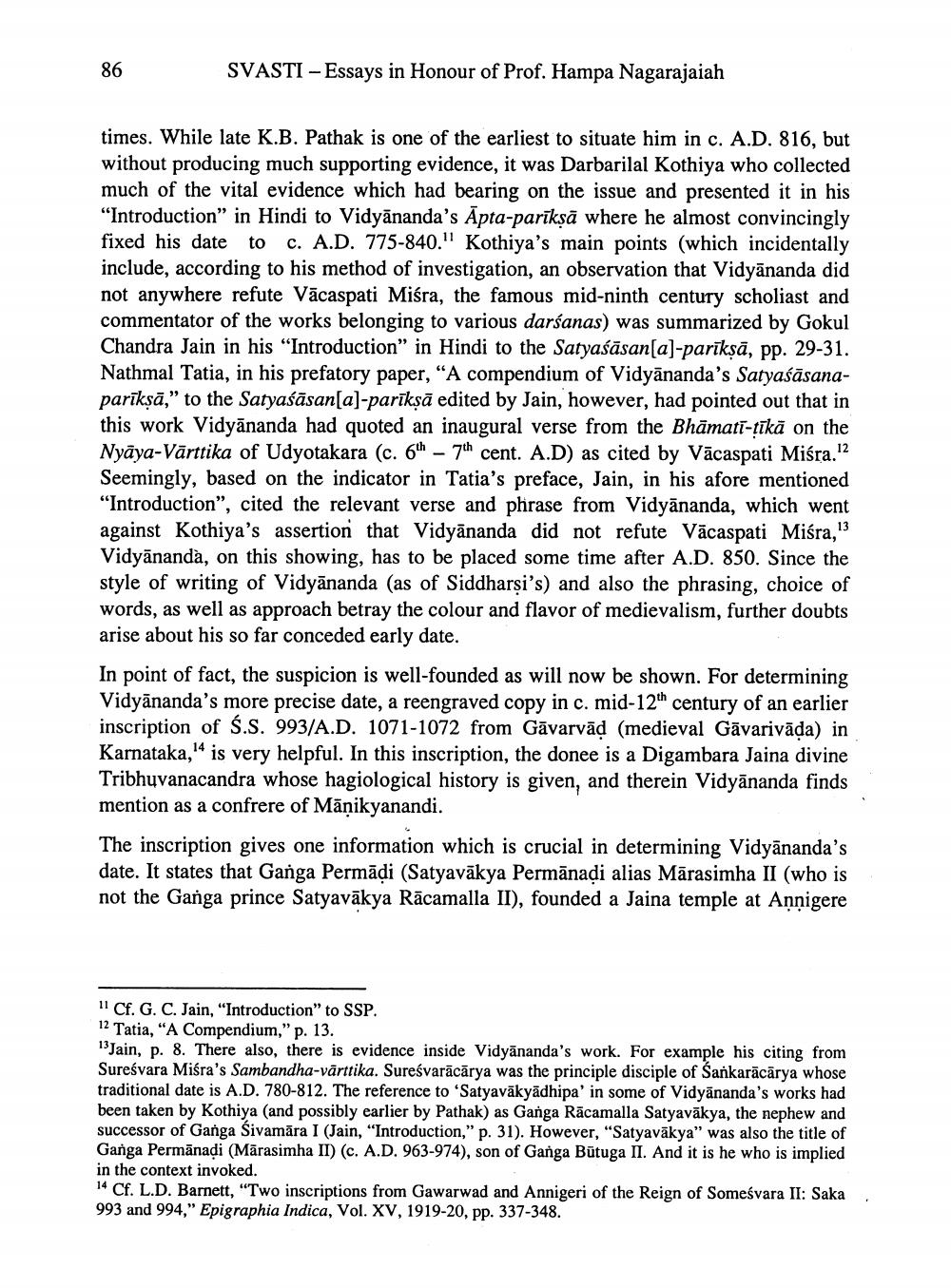________________
86
SVASTI - Essays in Honour of Prof. Hampa Nagarajaiah
times. While late K.B. Pathak is one of the earliest to situate him in c. A.D. 816, but without producing much supporting evidence, it was Darbarilal Kothiya who collected much of the vital evidence which had bearing on the issue and presented it in his "Introduction" in Hindi to Vidyānanda's Āpta-parikṣā where he almost convincingly fixed his date to c. A.D. 775-840." Kothiya's main points (which incidentally include, according to his method of investigation, an observation that Vidyānanda did not anywhere refute Vācaspati Miśra, the famous mid-ninth century scholiast and commentator of the works belonging to various darśanas) was summarized by Gokul Chandra Jain in his "Introduction" in Hindi to the Satyaśāsan[a]-parikṣā, pp. 29-31. Nathmal Tatia, in his prefatory paper, "A compendium of Vidyānanda's Satyaśāsanaparīkņā,” to the Satyaśāsan[a]-parīkņā edited by Jain, however, had pointed out that in this work Vidyānanda had quoted an inaugural verse from the Bhāmati-tīkä on the Nyāya-Vārttika of Udyotakara (c. 6th - 7th cent. A.D) as cited by Vācaspati Miśra.12 Seemingly, based on the indicator in Tatia's preface, Jain, in his afore mentioned "Introduction”, cited the relevant verse and phrase from Vidyānanda, which went against Kothiya's assertion that Vidyānanda did not refute Vācaspati Miśra,13 Vidyānandà, on this showing, has to be placed some time after A.D. 850. Since the style of writing of Vidyānanda (as of Siddharsi's) and also the phrasing, choice of words, as well as approach betray the colour and flavor of medievalism, further doubts arise about his so far conceded early date. In point of fact, the suspicion is well-founded as will now be shown. For determining Vidyānanda's more precise date, a reengraved copy in c. mid-12th century of an earlier inscription of S.S. 993/A.D. 1071-1072 from Gāvarvād (medieval Gāvarivāda) in Karnataka, '4 is very helpful. In this inscription, the donee is a Digambara Jaina divine Tribhuvanacandra whose hagiological history is given, and therein Vidyānanda finds mention as a confrere of Māņikyanandi. The inscription gives one information which is crucial in determining Vidyānanda's date. It states that Ganga Permādi (Satyavākya Permānadi alias Mārasimha II (who is not the Ganga prince Satyavākya Rācamalla II), founded a Jaina temple at Annigere
11 Cf. G. C. Jain, "Introduction" to SSP. 12 Tatia, "A Compendium," p. 13. 13 Jain, p. 8. There also, there is evidence inside Vidyānanda's work. For example his citing from Sureśvara Miśra's Sambandha-vārttika. Sureśvarācārya was the principle disciple of Sankarācārya whose traditional date is A.D. 780-812. The reference to 'Satyavākyādhipa' in some of Vidyānanda's works had been taken by Kothiya (and possibly earlier by Pathak) as Ganga Rācamalla Satyavākya, the nephew and successor of Ganga Sivamāra I (Jain, "Introduction," p. 31). However, "Satyavākya" was also the title of Ganga Permānadi (Mārasimha II) (c. A.D. 963-974), son of Ganga Būtuga II. And it is he who is implied in the context invoked. 14 Cf. L.D. Barnett, "Two inscriptions from Gawarwad and Annigeri of the Reign of Someśvara II: Saka, 993 and 994," Epigraphia Indica, Vol. XV, 1919-20, pp. 337-348.




